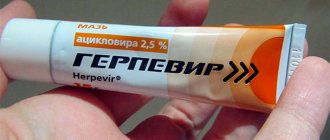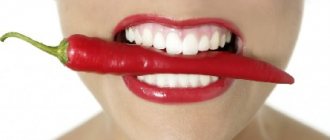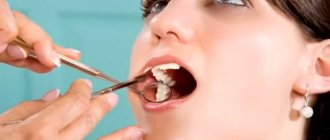Each of us has had ulcers on the lip at least once, regardless of gender, age and other differences.
What does their presence mean? In what situations do ulcers occur in the mouth due to biting, and when should you seek help from a doctor? We will answer all questions in this article. Most often, painful mouth ulcers on the lip are found after a good night's sleep. It happens that you awkwardly laid your head, and your jaw shifted, and your teeth bit the soft tissue of the mucous membrane. The next morning, this place may swell, a small bubble will appear, which will cause pain when talking or eating. In such situations there is no need to worry. After a while, the ulcer on the inside of the lip will disappear. This usually takes a couple of hours or a day.
Much more unpleasant are cases when a painful mark does not disappear for several days, and subsequently similar formations are found in the mouth. They indicate that you are faced with ulcerative stomatitis. This is the name of an inflammatory disease that is accompanied by white sores on the lips, as well as on the palate, tongue and inner sides of the cheeks.
In a similar way, a complex form of stomatitis manifests itself, in which it is difficult to eat food, there is a tendency to dehydration and infectious infection (often diagnosed in patients with immunodeficiency).
The causes of the disease are:
- low immunity;
- alcohol and cigarette abuse;
- oral injuries;
- transfer of bacteria into the mouth through unwashed foods, household items, etc.;
- drinking low quality water and food.
In some situations, the disease can be triggered by allergic or toxic reactions to medications, materials and drugs used in dental procedures. Hormonal imbalances, circulatory problems, intestinal inflammation and stress also cause the disease.
Factors contributing to the formation of bubbles:
- Oral diseases: caries, pulpitis, periodontitis, stomatitis;
- Unbalanced diet;
- Allergy to toothpaste or mouthwash;
- Injuries;
- Poor hygiene;
- Hereditary predisposition;
- Hormonal imbalance;
- Immunity impairment;
- Alcohol and nicotine addiction.
Watery blisters on the mucous membrane in some cases can indicate the occurrence of serious diseases. Such manifestations occur with tuberculosis, syphilis or diabetes. Therefore, if such a pathology occurs, it is recommended to immediately make an appointment with a doctor and undergo the necessary examination. The first sign is the sensation of a strange object in the mouth that is in the way.
Reasons for appearance
- Mechanical damage to the mucous membrane - injury to the lips by teeth or due to a blow, burn or piercing, ingestion of solid food (caramel, sugar, salt). Bubble formations filled with liquid appear.
- Failure to maintain oral hygiene , the presence of dental plaque, the proliferation of harmful bacteria in damaged teeth, oral dysbiosis, microtrauma during prosthetics and fillings. These factors are the cause of the development of stomatitis .
- The contact of viral particles on the mucous membrane , intrauterine infection of the fetus (acne in newborns) contributes to the disease of herpes .
- Decreased immune defense of the body , consumption of unwashed food, use of broad-spectrum antibiotics, malignant tumors, treatment with glucocorticosteroids. A concomitant disease of the oral cavity is candidiasis .
- Allergic reaction to medications or food.
White pimples on the inside of the lips
Photo 1: The appearance of white rashes in the oral cavity is usually accompanied by painful sensations that intensify while eating food, sour drinks, tea or coffee.
Source: flickr (Joseph Doyle). Repeated appearance of white pimples indicates various pathological diseases of internal organs.
Causes of white pimples on lips:
- allergic reaction to decorative cosmetics;
- dermatitis;
- colds;
- disturbances in the body's hormonal system;
- smoking;
- failure to comply with hygiene rules.
White rashes can appear due to a combination of several factors . Depressive states, stress, and congenital anomalies of the gallbladder can aggravate the pathology
The appearance of white pimples during pregnancy indicates the development of the following pathologies:
- disturbances in liver function;
- disruption of the adrenal glands;
- chloasma - hyperpigmentation of the skin.
Symptoms
- Painful sensations when eating occur if a bubble has formed in the gum area or on the tongue;
- Pain when talking or smiling appears when a formation occurs on the inner surface of the lip;
- Pain in the throat area occurs if the bubble is located at the root of the tongue.
Transparent and bloody blisters can be not only inflammatory in nature. If the formation does not cause pain and is not accompanied by swelling, then you should consult a dermatologist. It is not recommended to treat yourself in such a situation, as it can be dangerous to health.
How to deal with acne?
Treatment for acne depends on the severity of the disease. It is prescribed exclusively by a specialist. For mild to moderate acne, external therapy is primarily used18. For severe acne, emphasis is placed on systemic treatment18.
Clindovit® is a topical antibiotic that can be prescribed for acne vulgaris6. The main active ingredient in its composition is the antibiotic lincosamide clindamycin6. It fights a wide range of propionibacteria strains6. After contact with the skin, clindamycin quickly accumulates in comedones, exhibiting antimicrobial activity6. Clindovit® gel helps reduce free fatty acids on the skin6.
The drug must be applied twice a day (morning and evening) to previously cleansed and dry skin. The first results from treatment with a topical antibiotic usually become noticeable after 6-8 weeks. It is recommended to combine the use of the drug with the use of benzoyl peroxide or azelaic acid (Azelik® gel)18,28.
Treatment methods depending on the cause:
- If the formation occurs due to a viral infection, then treatment will be based on the use of antiviral drugs;
- If the cause is injury, then it is necessary to eliminate the consequences and rinse the mouth with antiseptics;
- If an allergic reaction provokes an illness, then you should find out what the irritant is and not use it anymore. The doctor will also prescribe antihistamines;
- If a large bloody bubble has formed, then surgery is performed. After this, the doctor prescribes medications for rapid tissue regeneration and restoration.
How to get rid
It should be noted that there is no universal medication for acne. Bumps can form for many reasons. If neoplasms appear systematically, it is recommended to consult a specialist. The specialist will conduct a diagnosis and prescribe a treatment regimen aimed at combating a particular pathology.
Cosmetic procedures
Cosmetology salons offer the removal of white pimples on the lips through laser therapy. The goal of the procedure is to restore the aesthetic appearance of the lips.
The manipulation involves the following stages:
- The patient is seated in a special chair.
- A cosmetologist performs local anesthesia of the epithelial layer.
- The laser is applied.
- After the procedure is completed, an antiseptic bandage is applied.
In most cases, 2 procedures are required. Treatment depends on the area of the lesion. It takes a week for the tissue to completely recover. The new layer of epidermis does not contain acne and acquires a natural color.
Small pimples on the lip containing fat in the lip area do not degenerate into malignant tumors. The concentration of subcutaneous sebum in acne is low. Beauty salons offer 2 main methods for removing them. Each of them is used for specific clinical indications.
The table shows the main techniques:
| Method | Description |
| Cryodestruction | It is assumed that tumors will be burned out using low temperatures. A liquid nitrogen solution with a temperature of -195 °C is used. A solution of liquid nitrogen is precisely applied to the area of the lip. The dose of the substance is low, but this concentration is sufficient to eliminate the rash. After skin regeneration, the pimples disappear. |
| Plastic surgery | The procedure is indicated for patients who have developed acne with a diameter of more than 2 mm. Wen covers the entire surface of the lips, contributes to a decrease in the quality of life, and creates a cosmetic defect. Eliminating the tumor using laser and cryodestruction is impossible. The plastic surgeon removes the cyst capsule. Manipulation helps restore normal circulation of subcutaneous sebum in the ducts. The duration of the operation is 1.5-2 hours. Full recovery requires 2 weeks. General anesthesia is performed. |
The main disadvantage of cryodestruction and the surgical method is the likelihood of relapse of the pathology.
You can disguise pimples through permanent tattooing. The lip area is covered with paint. The procedure is contraindicated in case of exacerbation of herpes. For the purpose of prevention, a therapeutic course involving the use of antiviral drugs is required. Makeup is updated once every 2-3 years.
Classification of rashes on the labia
Before answering the question of why acne appeared on the labia, for a correct assessment of the pathology process, it is important to be able to differentiate the elements that make up the rash.
According to dermatological terminology, primary ones are distinguished, appearing on unchanged skin.
And secondary elements, developing from primary ones.
Actually, in most situations, various types of acne on the labia belong specifically to the primary forms.
They are divided into cavity and cavityless.
Sometimes the transition from primary to secondary forms occurs very quickly.
In such a situation, knowledge of the specifics and patterns of transformation makes it possible to determine the type of previous education.
Primary elements include:
- A spot (artificial, non-inflammatory and inflammatory vascular, pigmented) is a limited change in skin color without cavities or elevations. Vascular formations of an inflammatory nature up to a centimeter in size are called roseola, from one to five centimeters - erythema. Examples include roseola syphilitica, erythematous variants of dermatitis, and toxicoderma. Possible secondary forms are secondary pigment spot, scale.
- A blister is a raised, cavity-free formation, the result of edema with acute inflammation in the papillary skin layer, which quickly appears/disappears. It can form due to urticaria, insect bites, and toxicoderma. Such itchy pimples on the labia are usually pink, less often whitish in the central zone, and may be accompanied by a burning sensation.
- Papules, otherwise known as nodules, are hollow, raised elements that usually pass without a trace. Such formations vary in size, depth, and can be inflammatory or non-inflammatory in nature. They may transform into cracks, scales, secondary pigment spots, lichenification (thickening, pigmentation disorders, deepening of the skin pattern). In some diseases, papules merge to form plaques.
- A tubercle is a hollow, raised, dense element up to a centimeter in size, which usually leads to the formation of scars and cicatricial atrophy. It can also develop into ulcers, growths, scales, and crusts. The formation lies deep in the skin and is observed in cases of tuberculosis, leishmaniasis, leprosy, and tertiary syphilis.
- A node is a hollow, raised element measuring over a centimeter (up to 10 cm). It may end without a trace or with the formation of a scar, ulcer, secondary pigment spot, or crust. Formed in the subcutaneous tissue. A subcutaneous pimple on the labia of inflammatory nature may turn out to be syphilitic gumma, a typical manifestation of tertiary syphilis. Non-inflammatory is formed due to the deposition of metabolic products (“pimple wen” on the labia) or as a result of neoplasms (lymphoma).
- A vesicle, otherwise known as a vesicle, is a cavitary single- or multi-chambered elevated formation, up to 5 mm in diameter, with a tire and a bottom. On the labia with genital herpes, watery pimples with serous contents appear on erythematous skin. Also, blisters on the labia are filled with serous-hemorrhagic contents (blood pimples). When the vesicles are opened, weeping erosions, scales, crusts, and secondary pigment spots may appear, but usually in the end there are no traces left on the skin.
- Bubble, bulla - differs in size from the bubble (its radius exceeds a quarter of a centimeter, and can even reach several centimeters). Resolves without a trace or with scarring. It is also possible to form erosions, scales, crusts, growths and age spots.
- Pustule, abscess - a cavitary deep or superficial raised formation with purulent contents (a pimple with pus is found on the labia). There are follicular, predominantly staphylococcal in nature, and non-follicular (superficial - phlyctena, deep - ecthyma), usually streptococcal. They can develop into crusts, erosions, spots, scars, ulcers, and growths. Follicular pustules form in the hair follicle, appearing on the labia as characteristic yellow pimples.
Secondary elements:
- scale – loosened horn cells in the form of a layer
- crust – drying contents of primary formations
- crack - a violation of the integrity of the skin that occurs due to a decrease in elastic properties
- abrasion - mechanical damage to the surface layer of skin
- erosion - a defect within the surface layer that appears when formations with a cavity are opened
- ulcer – deep skin defect
- scar - the formation of new connective tissue during the healing of skin defects
- cicatricial atrophy - cicatricial transformation without previous skin damage
- lichenification – thickening, dryness, compaction, staining, deepening of the skin pattern
- vegetation - growth of a skin area in an area of prolonged inflammation
- hyper- and hypopigmentation – weakening/increasing coloration of a skin area
Genital warts on the labia
Anogenital warts, also called condylomas acuminata, are caused by the human papillomavirus.
They are formations of a characteristic appearance: their lobed structure makes them look like a cauliflower stalk.
Such a pimple forms inside the labia, near the vestibule of the vagina, anus.
There are also varieties with a smooth surface and the color of raw meat (papular warts).
Separately, there is a giant Buschke-Levenshtein condyloma, which can form during pregnancy or in people with reduced immunity.
It is important to differentiate genital warts from broad ones, manifestations of secondary syphilis.
The latter are a dense purple, red dark pimple with a wide base on the labia.
Bowenoid papulosis is a relatively rare disease.
It also occurs when infected during sexual contact with the human papillomavirus (type 16, high cancer risk group).
The main complaint of patients is that a flesh-colored, brown or red pimple has appeared in the pubic area, inguinal folds, perianal area, and on the labia.
Gradually, such papules merge into plaques with a warty surface.
Approximately 3% of cases of the disease result in malignancy.










